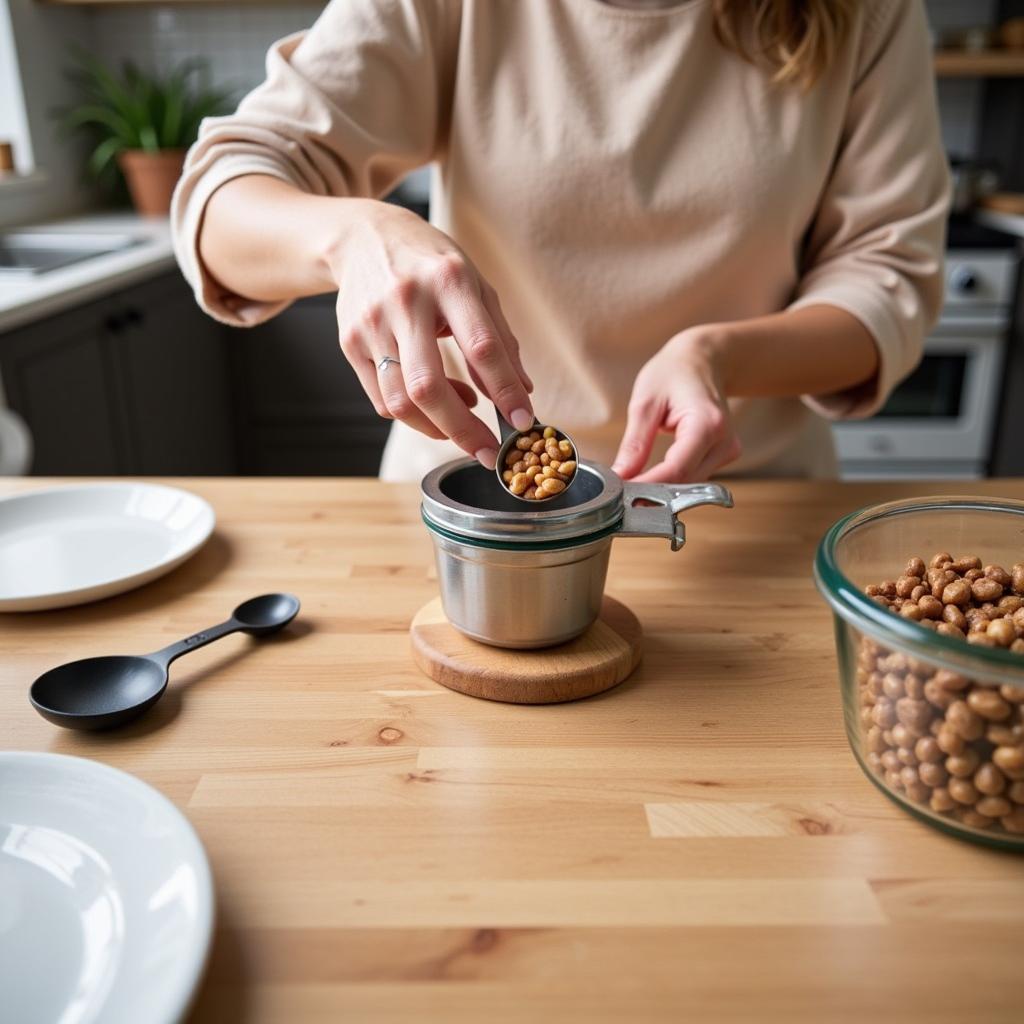Dealing with a dog with allergies can be tough. You hate seeing your furry friend suffer from itchy skin, upset stomach, or constant ear infections. The good news is that dietary changes, specifically switching to hypoallergenic dog food, can make a world of difference. While commercially prepared hypoallergenic food can be expensive, this guide will equip you with everything you need to know to whip up delicious and nutritious homemade Hypoallergenic Dog Food Recipes that will have your pup feeling their best!
Understanding Food Allergies in Dogs
Just like humans, dogs can develop allergies to certain ingredients in their food. The most common culprits are proteins like beef, chicken, dairy, and wheat. When a dog with a food allergy consumes these ingredients, their immune system overreacts, leading to a range of uncomfortable symptoms.
Benefits of Homemade Hypoallergenic Dog Food
While commercial hypoallergenic dog food options exist, many dog owners find that preparing their pup’s meals at home offers several advantages:
- Complete Control over Ingredients: You know exactly what’s going into your dog’s food, ensuring it’s free from potential allergens.
- Fresher Ingredients: Homemade food means fresher ingredients, which often translates to better nutrient absorption and overall health.
- Cost Savings: Cooking in bulk can be more economical than purchasing specialized dog food, especially for larger breeds.
- Special Dietary Needs: Homemade food allows you to cater to your dog’s specific needs, whether they have allergies, sensitivities, or other health concerns.
Choosing the Right Ingredients
The key to successful hypoallergenic dog food is choosing ingredients that are unlikely to trigger your dog’s allergies. Here’s a breakdown of some great options:
Protein Sources:
- Salmon: Rich in omega-3 fatty acids, which are great for skin and coat health.
- Venison: A novel protein source that’s less likely to cause an allergic reaction.
- Kangaroo: Another novel protein that is lean and highly digestible.
- Duck: A good source of iron and often well-tolerated by dogs with allergies.
Carbohydrates:
- Sweet Potatoes: Easily digestible and a good source of fiber and vitamins.
- Brown Rice: A whole grain that provides energy and essential nutrients.
- Quinoa: A complete protein source that’s also gluten-free.
- Pumpkin: High in fiber and helps regulate digestion.
Fruits and Vegetables:
- Carrots: An excellent source of vitamin A, which is important for eye health.
- Green Beans: Low in calories and packed with vitamins and minerals.
- Apples: A good source of fiber and vitamin C (remove seeds and core).
- Blueberries: Rich in antioxidants and may help boost the immune system.
 A dog owner preparing a homemade hypoallergenic meal for their dog
A dog owner preparing a homemade hypoallergenic meal for their dog
Hypoallergenic Dog Food Recipe Ideas
Recipe 1: Simple Salmon and Sweet Potato
Ingredients:
- 1 pound boneless, skinless salmon
- 2 cups cooked and mashed sweet potato
- 1 cup cooked brown rice
- 1 tablespoon coconut oil
Instructions:
- Preheat oven to 350°F (175°C).
- Bake salmon for 15-20 minutes, or until cooked through.
- Flake the cooked salmon.
- In a large bowl, combine the flaked salmon, mashed sweet potato, cooked rice, and coconut oil.
- Mix well and serve.
Recipe 2: Hearty Venison and Veggie Stew
Ingredients:
- 1 pound ground venison
- 1 cup chopped carrots
- 1 cup chopped green beans
- 1 cup cooked quinoa
- 2 cups water
Instructions:
- In a large pot or Dutch oven, brown the ground venison over medium heat.
- Add the chopped carrots, green beans, and water.
- Bring to a boil, then reduce heat to low and simmer for 20-25 minutes, or until vegetables are tender.
- Stir in cooked quinoa and serve.
Transitioning to a Hypoallergenic Diet
It’s important to transition your dog to a new diet gradually to avoid digestive upset. Start by mixing a small amount of the hypoallergenic food with their current food, gradually increasing the ratio of new food over 7-10 days until they are fully transitioned.
Important Considerations:
- Consult Your Veterinarian: It’s crucial to talk to your vet before making any significant changes to your dog’s diet, especially if they have known allergies. Your vet can help you determine the best course of action and rule out any underlying medical conditions.
- Nutritional Balance: Ensure the recipe you choose provides complete and balanced nutrition for your dog’s age, breed, and activity level. Adding a dog-specific vitamin and mineral supplement can be beneficial.
- Portion Control: Feeding the right amount is essential for maintaining a healthy weight. Follow the feeding guidelines provided by your veterinarian or use a reputable online calculator to determine your dog’s ideal daily caloric intake.
 A happy and healthy dog enjoying a bowl of homemade hypoallergenic dog food
A happy and healthy dog enjoying a bowl of homemade hypoallergenic dog food
Conclusion
Creating homemade hypoallergenic dog food can be a rewarding experience for both you and your furry companion. By understanding the basics of food allergies in dogs and choosing the right ingredients, you can provide your pup with delicious and nutritious meals that address their specific needs and help them thrive. Remember to consult with your veterinarian throughout the process to ensure your dog is receiving the best possible care.
FAQs About Hypoallergenic Dog Food Recipes
1. How can I tell if my dog has a food allergy?
Common signs of food allergies in dogs include itchy skin, digestive issues (vomiting, diarrhea, gas), ear infections, and excessive licking or chewing of the paws.
2. How long does it take for a dog’s allergies to improve on a hypoallergenic diet?
It can take anywhere from a few weeks to a few months to see significant improvement in your dog’s allergy symptoms after switching to a hypoallergenic diet.
3. Can I give my dog treats if they are on a hypoallergenic diet?
Yes, but make sure the treats are also hypoallergenic and made with ingredients that won’t trigger your dog’s allergies.
4. Can puppies eat hypoallergenic dog food?
Yes, but it’s best to choose a recipe specifically formulated for puppies to ensure they are getting the nutrients they need for growth and development.
5. What if my dog doesn’t like the homemade hypoallergenic food?
Some dogs might be hesitant to try new foods. Be patient and try adding a small amount of low-sodium bone broth or mixing the new food with their old food to entice them.
If you need further assistance or have specific questions, don’t hesitate to reach out. Our dedicated customer support team at Mina Cones Food is here to assist you 24/7. Contact us via Phone: 02437655121, Email: minacones@gmail.com, or visit us at our address: 3PGH+8R9, ĐT70A, thôn Trung, Bắc Từ Liêm, Hà Nội, Việt Nam.
Explore More:
- For more recipe inspiration, check out our other blog posts on dog-friendly recipes.
- Learn about the importance of high-quality ingredients in your dog’s diet.
- Discover our range of all-natural dog treats, perfect for pups with allergies.